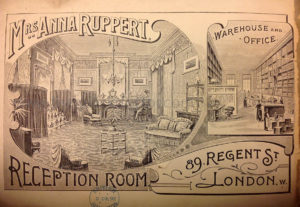Source: The General Advertiser, 19 Jan 1748
.
I mentioned the Purging Sugar Plumbs for Worms early in the life of this blog, but didn’t include much beyond the ad itself, and I hardly had any readers then anyway, so I think it’s worth revisiting – especially as this advert is so delightfully worded and cheerfully revolting.
At some point in the early 1740s, a Mr Burchell took over the ownership of another remedy, the Anodyne Necklace, which had been on sale for decades as a cure for babies’ teething pain. He built up his business on this and the worm remedy, fending off imitators with some innovative advertising methods – not least the eye-catching newspaper ads showing exactly what might be gnawing at your intestines (the inclusion of the insect thing on the right is an inspired bit of added horror).
One of Burchell’s methods was to entice punters to his premises by giving away free almanacks and pamphlets. In 1750 he was quick to exploit the fear caused by the earth tremors that had shaken London, by publishing:
ANOTHER EARTHQUAKE
Much Worse than the Two Last. When, and What Time to be Expected? With a Surer SAFEGUARD, Against it, than Going Out of Town. And, Why the Last Two EARTHQUAKES happened to be in this one particular Jubilee Year, more than in Any other Year?
The Almanack referred to in the ad above is intriguing – what could it contain that other almanacks left out? Although the content changed each year, a 1750 ad goes into more detail:
In the Month of Lent, is a large LIST of Other Fasters from FLESH CONVERSATION as well as FLESH DIET, Such as MISERS, WORN-OUT Sinners, etc.
The Miser’s CHAST, ’cause he won’t PAY a Wh—re
The Worn-Out’s CHAST, ’cause He can Sin NO MORE
And, All the Other Months, have also their OWN proper TIMELY Observations, Not to be Met With, in Any of the COMMON ALMANACKS, but Only in THIS One, Which Tells What THEY Don’t.
Fun for all the family, by the sounds of it.
Later in the 18th century, the theme of free stuff continued, with Basil Burchell (who I think was the son of the original proprietor, but I’m not sure) issuing coin-like advertising tokens with the sugar plumbs on one side and the Anodyne Necklace on the other (he used the spelling ‘sugar plumbs’ in his ads too). The tokens usually had a hole in them so they could be worn on a ribbon.
Worm medicines were a good bet for a quack, because although intestinal worms were very common, especially in young children, this didn’t make them any nicer to have than they would be nowadays. The symptoms of untreated worm infestations were bad enough, but this was accompanied by the downright horror of being inhabited by living creatures. J Cook, a correspondent to the London Magazine in 1768, gave a description of the main varieties:
There are three sorts of worms which generally infest the human body. The round ones, the broad ones, and ascarides. Sometimes, but seldom, anomalous ones are discharged, viz. horned, hairy, with four feet, with two heads, with three, and some with four forked tails, etc.
The very thought of what might be in there led some people to go to extraordinary lengths to get rid of them, and I will blog about a couple of examples in my next post.




Fascinating article and illustration.
Does the spelling “plumbs” suggest that the recipe for Basil Burchell’s Purging Sugar Plumbs contained lead?
Ah, interesting idea! I don’t know what was in these, but I think it’s most likely they contained mercury as this was popular as a vermifuge in orthodox and proprietory medicines at the time. Probably a selection of herbs too, but there were various ones used against worms so I can’t guess which Burchell would have chosen.
It has long been my contention that we totally underestimate how endemic intestinal worms were in the past. I think this helps account for the wild popularity of medicine shows and traveling fringe docs in the US West in the 19th C–they were often really selling vermifuges.
The prevalence of intestinal worms has often occurred to me when writing historical fiction – many characters would probably have them, and yet I think readers would draw the line at infested heroes and heroines!
I’ve never looked much into the US travelling medicine shows – an area I’d like to find out more about.